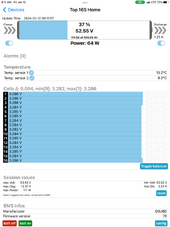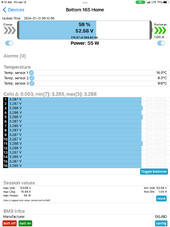You are using an out of date browser. It may not display this or other websites correctly.
You should upgrade or use an alternative browser.
You should upgrade or use an alternative browser.
1 or 2 shunts?
- Thread starter wsaharem
- Start date
MisterSandals
Participation Medalist
If you suspect the battery SoC’s will be different (like if the batteries are different) then 2 would provide more info.Does it make sense to have 2 shunts to track SOC for each battery, or should I just do 1 for the entire battery set?
I have an 280Ah LiFePO4 in parallel with an 305Ah LiFePO4 battery and a single shunt.
I have been watching them for 3 weeks thru BMS apps and do not see a need for me to have 2 shunts. YMMV
LakeHouse
Solar Enthusiast
One should be sufficient unless you have some specific need to track individual states of charge accurately.
rodrick
Free energy enthusiast
If your cables and connections are all the same 1 shunt should be fine
Can they be if same chemistry and connected in parallel?If you suspect the battery SoC’s will be different
LakeHouse
Solar Enthusiast
For LFP, yes they definitely could be different states of charge at the same voltage. But does it really matter if one of your LFP batteries is at 50% and the other is at 70%? Almost certainly not.Can they be if same chemistry and connected in parallel?
MisterSandals
Participation Medalist
3 weeks ago I would have suspected that they would charge and discharge similarly.Can they be if same chemistry and connected in parallel?
But my batteries are different sizes and different histories so I am not surprised my BMSs show differences.
To be honest though, I don’t have confidence in BMS SoC readings so I am NOT surprised or alarmed by seeing one at 35% and the other at 50% (same voltage).
I am still observing and learning.
Interesting... I would have thought that a correctly designed system with same wire lengths to both batteries, then once they are charged to 3.45V or more they'll both be at 99-100% ish and would then keep synchronised. Be good to learn more about that as you observe more.
MisterSandals
Participation Medalist
MisterSandals
Participation Medalist
I have not had enough sun to get them charged much higher than 3.31V so I have some learning ahead of me.then once they are charged to 3.45V or more they'll both be at 99-100% ish and would then keep synchronised.
This system is in full AC support 24/7. Charged by 3250W micro inverters to Schneider SW4048.
rodrick
Free energy enthusiast
I found this post interesting

 diysolarforum.com
diysolarforum.com

Calculation of parallel string battery currents
Hi, everybody! I'm a retired EE. I didn't want my EE skills to fade away after retirment, so I exercise them when I can. Whenever I see a non-trivial circuit analysis problem on one of various forums I frequent, I challenge myself to solve it. Recently I watched Will's video about current...
LakeHouse
Solar Enthusiast
You should expect them to sync to the same state of charge at the top (as you note), and at the bottom, i.e. above and below the flat parts of the curve. But in the flat region, minor differences in the batteries, even if they're as identical as is possible (same connections, matched cells of the same age, same BMS, etc.) would mean that at a particular voltage, each batteries preferred SoC might be different.Interesting... I would have thought that a correctly designed system with same wire lengths to both batteries, then once they are charged to 3.45V or more they'll both be at 99-100% ish and would then keep synchronised. Be good to learn more about that as you observe more.
So in MisterSandals 52.55V state, one battery is at 37% and the other is at 59% and they're both happy. If you charge or discharge, the system voltage will change and each battery will again find its happy SoC at the new voltage, and that may involve some transfer of energy from one battery to another. But for LFP, that isn't something we need to worry about, it happens with almost no losses.
The forum has lots of posts about "Why aren't my LFP batteries at the same SoC???" And the the answer should be: "Because you should expect them to be at different SoC at the same voltage." But unfortunately it's usually "Are your cables the same length?". Which is a good answer for Lead-acid, but a bad answer for LFP, in my opinion.
MisterSandals
Participation Medalist
That is one of my favourites and I have pointed other threads there to read at least first 4 posts to understand the concept.I found this post interesting
An update (last one, sorry if taking this off track), updated bottom battery to 280Ah (both now 5Ah below spec). Not much different from previous SoC oddities.

DIYrich
Solar Wizard
TL;dr: If all batteries are the same, then one shunt is fine. Otherwise a shunt for each type of battery may give you minor intel into them.
I have 2 racks of 15kWh batteries (3 5kWh batteries in each rack) , and one DIY 15kWh battery (total of 45kWh). Each rack, and the DIY have their own shunt. It was easier to wire that way. I noticed minor differences in charging with the rack batteries, and moved the better batteries into one rack, and weaker batteries into the other.
The 2 racks track with each other, and the DIY behaves is a little different. the DIY seems to be keeping the 2 racks topped up. Might be differences in length of wire (3 feet vs 4 feet, plus internal wiring). Not enough that I'm worried about.
With the multiple shunts, I can see power movement between batteries. Interesting to know, but not sure it really tells me anything. If I ever have a battery problem, having multiple shunts will make it easier to isolate the problem battery.
I have 2 racks of 15kWh batteries (3 5kWh batteries in each rack) , and one DIY 15kWh battery (total of 45kWh). Each rack, and the DIY have their own shunt. It was easier to wire that way. I noticed minor differences in charging with the rack batteries, and moved the better batteries into one rack, and weaker batteries into the other.
The 2 racks track with each other, and the DIY behaves is a little different. the DIY seems to be keeping the 2 racks topped up. Might be differences in length of wire (3 feet vs 4 feet, plus internal wiring). Not enough that I'm worried about.
With the multiple shunts, I can see power movement between batteries. Interesting to know, but not sure it really tells me anything. If I ever have a battery problem, having multiple shunts will make it easier to isolate the problem battery.
Similar threads
- Replies
- 4
- Views
- 211




